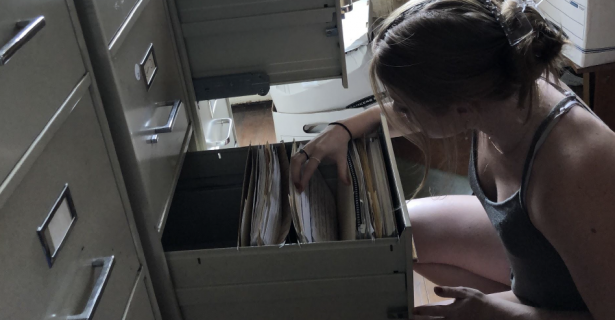One day in early July, I had the chance to visit the home of the late Dr. Gene Sharp, founder of the Albert Einstein Institution (AEI) and life-long scholar of nonviolent action. At the green front door of the quaint, four-story townhouse in East Boston, I was greeted by my supervisor Jamila Raqib, the Executive Director of AEI and mentee of Dr. Sharp. After joking about how crazy it was to finally see each other outside of Zoom and giving me a tour of the house, Jamila showed me a room off the bedroom.
In it lay filing cabinets and banker’s boxes filled to their brims with journal articles, meeting minutes, and correspondence between Dr. Sharp and activists. These documents dated back to the early 1990s, and covered events ranging from the movement to end apartheid in South Africa, to dictatorial repression in Burma in 1995, to the Color Revolutions of the early 21st century. Shortly after opening the first drawer of the cabinet, Jamila pulled out several documents to take home, noting their striking relevance to events unfolding in the world of nonviolent resistance today.
As I stood and watched Jamila comb through AEI’s notable contributions to nonviolent movements, I developed a newfound appreciation for the decades of nonviolent action and scope of scholarship on the subject. What might have seemed like an afternoon of digging through dusty files quickly transformed into watching history unfold right in my hands. The cabinets showed something that history textbooks and mass media often does not: decades of behind-the-scenes planning, capacity-building, and learning, all of which are essential to building durable, influential movements.
Though the tools and tactics of nonviolent action — as well as governments’ responses to them — have evolved throughout the years, my time in Dr. Sharp’s house has shown me that there are many parallels that we can apply from past cases to movements today. I noticed these parallels especially when researching the current pro-democracy movement in Belarus, where protesters have adopted tactics from past movements and applied them to their own challenges. For instance, following harsh government oppression of large groups of protesters, a message on Nexta’s encrypted Telegram channel called for demonstrators to gather in “small groups of 20 people.” The message added, “Be like water,” a famous quote from martial arts star Bruce Lee and what eventually became a popular slogan among Hong Kong protesters.
While brutal repression has forced Belarusian leaders into exile and brought the movement to a standstill, history reveals some hope for the movement. Past case studies of successful nonviolent movements show similar periods of discouragement and dissolution. Furthermore, like Sudanese protesters in 2019 or the organizers of the civil rights movement in the 1950s and 60s, Belarusians have met brutal violence with increased defiance and political jiu-jitsu. Amazingly, people have emerged from widespread arrests, beatings, and torture more powerful than ever, and continue to organize against all odds. They have adjusted their repertoire, diversified participation, and have remained nonviolent.
While each case is unique, my time so far with the Albert Einstein Institution has taught me that there are many lessons to be drawn from history when looking toward the future of movements. When Dr. Sharp began studying Gandhi, he quickly realized that there was an extensive (and impressive) history of people using nonviolent means to dismantle oppressive governments. Perhaps my realization — in his house, surrounded by his academic work, close to sixty years later — was similar; that history is a testament not only to the power of past movements, but also to the potential of future ones to succeed.

